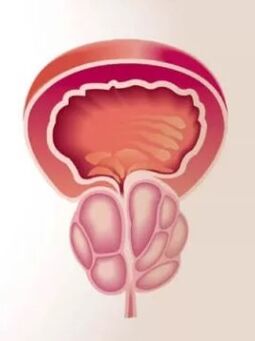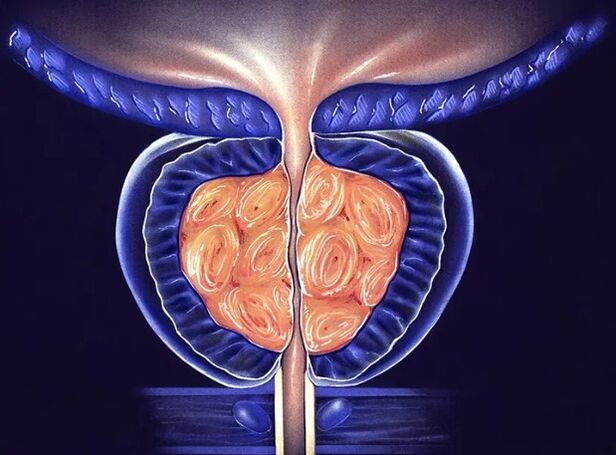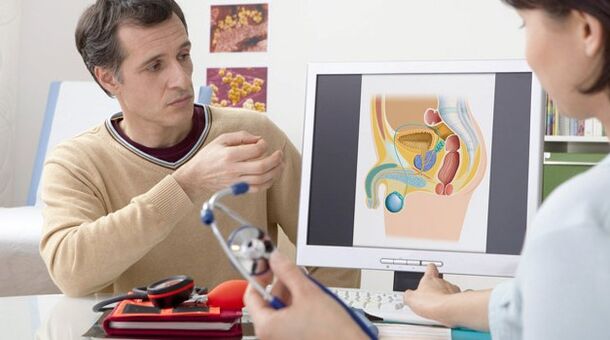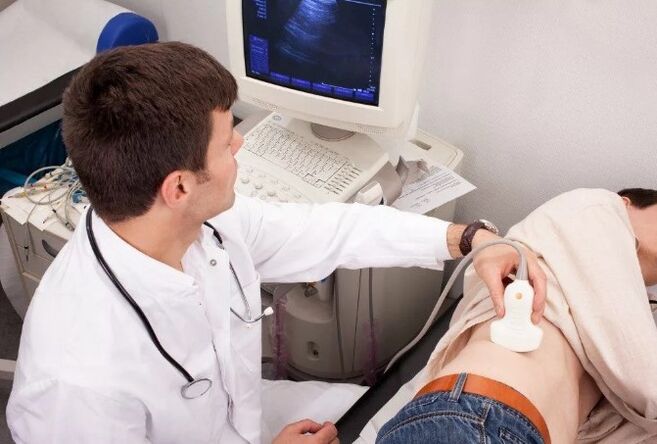
What is a prostate and why is it necessary?The prostate gland (prostate) is a small glandular organ of a man around the urethra under the bladder. The urethra is closely ended, forming one of its sphinca - a muscle socket designed to contain the urine. In its shape and size, the prostate looks like a chestnut nut, with which it is often compared to anatomists. The part of the urethra, which passes inside the gland, is called prostatic. Its convex rear part of the prostate is in contact with the rectum, it can therefore be easily felt with a rectal examination of the fingers. The front surface of the gland is close to the pubic joint and is linked to it with ligaments of connective tissue in motion, and the venous plexus is located between them. The prostate gland consists of lobules, each being made by cells - small bags bordered by secretory epithelium. The cells are interconnected by the output conduits in the form of tubes, which merge with each other, enlarged and end up falling into the simple part of the urethra. Inside the secretory bags, prostatic juice is synthesized and accumulated, which includes nutrients for sperm. It allows male sex cells to maintain its activity in the female body up to 5 days, which considerably increases the chances of fertilization. Illumination of the gland occurs at the time of ejaculation. Prostatic juice is mixed with the secrecy of the testicles and represents 10 to 30% of the final volume of sperm. So,The prostatic gland fulfills 2 main functions in a man's body:
Participate in the urination process - holds urine when muscle fibers are reduced and freely exceeds it when relaxed;Provides the viability of sperm, distinguishing nutritive prostate juice in ejaculation.What does the disease develop?Prostatitis is inflammatory changes in the prostate gland and it should be understood that they arise not only under the influence of bacterial microflora.The causes of inflammation can be factors resulting in damage to the gland tissue and the destruction of its cells.As in any other fabric, the inflammatory process of the prostate goes through certain stages:Alteration - damage to prostate cells.The squirrels of the cytoplasm, the fragments of the cell nucleus and the remains of membranes come out of the cells destroyed in the intercellular space - all are a signal of distress for the immune system. Immunity cells are starting to actively strive by the lesion, penetrating it from blood vessels and connective tissue. They throw biologically active substances in place of damage, under the influence of which blood vessels expand and cellular "strengthening" arrives. Exudation - The release of the liquid part of the blood of the vessels.Under the influence of immune cells, the walls of the dilated vessels become permeable to the plasma and it rushes in the damage to damage. If it is on the surface of a hollow organ or a channel of the gland, then the liquid part of the blood is released in its light, if the inflammation is tissue, swelling forms. Such a measure is necessary to limit the home of damage and prevent the additional propagation of the pathogen.Proliferation is the replacement of damaged cells with similar cells or connective tissue.The proliferation mechanism is launched a little later than the events described above and its course depends directly on the depth of the damage. The small foci of destruction of the fabric of the prostate gland are replaced by the same functional cells and the organ restores its entire work. The deep disorders are authorized through scars - the replacement of dead fabric with elements of connective tissue. Chronic prostatitis can ultimately lead to a complete atrophy of the prostate gland and the change in its secretory tissue in scar.
For the proposed reason, prostatitis is divided into:Acute bacterial- The pathogenic microflora causes serious damage to the prostate tissues with a pronounced inflammatory reaction. Most often, it develops with a infection by Gonococcus and other pathogens.Chronic bacterial-Association of pathogenic or conditional pathogenic bacteria causes slow inflammation, the activity of which remains for more than 2 months. As a rule, pathogens are streptococci, staphylococci, E. coli, klebsiella, mycoplasma, ureaplasma, chlamydia, herpesvirus and yeast type mushrooms. Chronic abacourish- In the presence of an inflammatory process in the prostate, it is not possible to detect a causal microflora. A similar form of the disease develops when the urine is sunk into the conduits of the prostate gland, stagnation of venous blood in the basin, violation of its emptying (rare or too frequent ejaculation). In the latter case, the disease is called stagnant prostatitis.How does the disease manifest itself?The easiest to diagnose acute prostatitis,which proceeds with signs of intoxication and inflammation pronounced. In a man, the temperature increases sharply to 38-39 degrees C, pain pronounced in the perineum, in the area of the rectum, appear. They can give in the groin, in the testicle, to the penis and to be so unbearable that the daily activity of a man is strongly disturbed. In some cases, the body temperature measured in the axillary cavity does not exceed normal indicators, but the rectal in any case will be 1 to 2 degrees per normal. The signs of prostatitis also become a violation of urination: the serious impulses to be urinated, after which it is impossible to retain either an acute delay in the urine due to severe edema of the gland. Sometimes the defecation becomes painful, because the prostate has enlarged in size takes place in the light of the rectum. Chronic prostatitisIn its manifestations, it is so diverse that it can easily be confused with another pathology. In the most typical cases, the symptoms of prostatitis are presented:
Pain in the crotch, pelvis.It is difficult for the patient to determine a specific place where it is located, often the pain spreads in the groin, the scrotum, the head and the stern of the penis, the sacrum. Its severity may be different: barely distinguished to intense stupid or drawing. Often, pain is associated with urination or ejaculation, occurs at the end or start of the process.MULTING OF MULT- The patient has frequent desires to empty the bladder, he must get up several times at night to urinate. However, the pressure of the jet is normal, urinary retention rarely develops.Sexual troubles- In the context of constant discomfort in the crotch of a man, an erection worsens and self -confidence disappears. The violations are aggravated if the pain is associated at the time of ejaculation: the patient cannot relax completely, because he expects unpleasant sensations. As a rule, with chronic prostatitis, the general-being well of a man is not disturbed, the body temperature is kept normal throughout the disease.How is the disease diagnosed?The diagnosis is established by the urologist or Andrologist doctorAfter examining the patient, the collection of an anamnesis and the study of symptoms. The doctor must discover the patient's contraception method, the presence of STIs in a sexual partner, the possibility of anal contacts without condom. These data facilitate the diagnosis and direct the doctor's thoughts in the right direction. The prescription of the symptoms of the disease or the discomfort in the perineum allows us to judge the evolution of prostatitis and its severity. The urologist necessarily examines the patient's genitals and performs a rectal examination of the prostate gland. To do this, he inserts a finger into the patient's rear passage and gropes the protruding prostate on the front wall of the rectum. Pain and size indicate the intensity of the inflammatory process. 
In addition, the doctor is carrying out a number of instrumental, microscopic, bacteriological and immunological studies in order to clarify the cause of the disease. The most common diagnostic method is the urine sample of 4 or 3 glass. The first method is more time and difficult to practice in practice, because it forces the patient on several occasions to consciously interrupt urination. The second modification is simpler: the patient urine continuously in three different containers in equal parts. The first part talks about the urethra state, the second of the pathology of the bladder and the kidneys, from the third, of the information on the state of the gland of the prostate is obtained. All the materials collected are studied under a microscope. With prostatitis in the third part of urine, leukocytes and sometimes bacteria are found.Access to the study of prostate and massage when collecting secretsFor microscopy, the secret of the prostatic gland is also taken.To do this, the doctor makes a prostate massage through the rectum wall for a while so that it is emptied in the urethra. SMOPs are made from the material collected in the laboratory, painted and studied in a strong increase. A sign of inflammation are leukocytes, bacterial etiology of the disease - bacteria in a smear. To determine the type of pathogen, the prostatic secret is sown on nutrients. If pathogenic microorganisms are present there, after 3 to 5 days, they form microbial colonies, which can then be studied by the bacteriological method allows you to obtain data on the sensitivity of microflora to antibiotics.Instrumental diagnostic methods, :Kidneys ultrasound;Confidence of the prostate with dopplerography - an ultrasonic sensor is inserted into the rectum for the best visualization of the prostate gland, its blood flow is also evaluated;Rising LAID is necessary with an obstinate prostatitis recurring course. An X-Ray contract is introduced into the urethra, after which a certain number of successive images are carried out.
By starting the treatment of chronic prostatitis, you must connect to a long struggle, because it is not always possible to cure it in a few weeks or even months. It is recommended to combine various methods and therapy tools, it is useful to improve pharmacotherapy with households. With stagnant prostatitis, regular sexual relations are necessary, interrupted sexual acts are unacceptable. The psycho-emotional context of the patient is important: depression, depression, personal life problems and the sexual sphere are able to cancel all the efforts of doctors. How to prevent?Prostatitis prevention includes:The use of barrier contraception methods (condom), in particular with regard to anal sex;Appropriate treatment of STIs;Regular sex life, bringing relationships to complete ejaculation;Prevention of crotch injuries, when classes, traumatic sports should be used by all possible protection methods;Compliance with personal hygiene;Ensure sufficient physical activity.Despite the fact that today prostatitis is not associated with the risk of developing adenoma or prostate cancer, the disease makes its owner suffer a lot of suffering. A man exhausted by chronic pain, feeling his sexual weakness, tired of prolonged treatment, changes in a significantly external way and that experienced doctors define these patients at first glance. To avoid such a spell, you must pay attention to your health, carefully protected with each new partner and treat sexually transmitted diseases over time. Prostatitis is not completely treated in all cases, but an experienced urologist is able to considerably improve the patient's condition and the quality of his life.

What does the disease develop?Prostatitis is inflammatory changes in the prostate gland and it should be understood that they arise not only under the influence of bacterial microflora.The causes of inflammation can be factors resulting in damage to the gland tissue and the destruction of its cells.As in any other fabric, the inflammatory process of the prostate goes through certain stages:Alteration - damage to prostate cells.The squirrels of the cytoplasm, the fragments of the cell nucleus and the remains of membranes come out of the cells destroyed in the intercellular space - all are a signal of distress for the immune system. Immunity cells are starting to actively strive by the lesion, penetrating it from blood vessels and connective tissue. They throw biologically active substances in place of damage, under the influence of which blood vessels expand and cellular "strengthening" arrives. Exudation - The release of the liquid part of the blood of the vessels.Under the influence of immune cells, the walls of the dilated vessels become permeable to the plasma and it rushes in the damage to damage. If it is on the surface of a hollow organ or a channel of the gland, then the liquid part of the blood is released in its light, if the inflammation is tissue, swelling forms. Such a measure is necessary to limit the home of damage and prevent the additional propagation of the pathogen.Proliferation is the replacement of damaged cells with similar cells or connective tissue.The proliferation mechanism is launched a little later than the events described above and its course depends directly on the depth of the damage. The small foci of destruction of the fabric of the prostate gland are replaced by the same functional cells and the organ restores its entire work. The deep disorders are authorized through scars - the replacement of dead fabric with elements of connective tissue. Chronic prostatitis can ultimately lead to a complete atrophy of the prostate gland and the change in its secretory tissue in scar.
For the proposed reason, prostatitis is divided into:Acute bacterial- The pathogenic microflora causes serious damage to the prostate tissues with a pronounced inflammatory reaction. Most often, it develops with a infection by Gonococcus and other pathogens.Chronic bacterial-Association of pathogenic or conditional pathogenic bacteria causes slow inflammation, the activity of which remains for more than 2 months. As a rule, pathogens are streptococci, staphylococci, E. coli, klebsiella, mycoplasma, ureaplasma, chlamydia, herpesvirus and yeast type mushrooms. Chronic abacourish- In the presence of an inflammatory process in the prostate, it is not possible to detect a causal microflora. A similar form of the disease develops when the urine is sunk into the conduits of the prostate gland, stagnation of venous blood in the basin, violation of its emptying (rare or too frequent ejaculation). In the latter case, the disease is called stagnant prostatitis.How does the disease manifest itself?The easiest to diagnose acute prostatitis,which proceeds with signs of intoxication and inflammation pronounced. In a man, the temperature increases sharply to 38-39 degrees C, pain pronounced in the perineum, in the area of the rectum, appear. They can give in the groin, in the testicle, to the penis and to be so unbearable that the daily activity of a man is strongly disturbed. In some cases, the body temperature measured in the axillary cavity does not exceed normal indicators, but the rectal in any case will be 1 to 2 degrees per normal. The signs of prostatitis also become a violation of urination: the serious impulses to be urinated, after which it is impossible to retain either an acute delay in the urine due to severe edema of the gland. Sometimes the defecation becomes painful, because the prostate has enlarged in size takes place in the light of the rectum. Chronic prostatitisIn its manifestations, it is so diverse that it can easily be confused with another pathology. In the most typical cases, the symptoms of prostatitis are presented:
Pain in the crotch, pelvis.It is difficult for the patient to determine a specific place where it is located, often the pain spreads in the groin, the scrotum, the head and the stern of the penis, the sacrum. Its severity may be different: barely distinguished to intense stupid or drawing. Often, pain is associated with urination or ejaculation, occurs at the end or start of the process.MULTING OF MULT- The patient has frequent desires to empty the bladder, he must get up several times at night to urinate. However, the pressure of the jet is normal, urinary retention rarely develops.Sexual troubles- In the context of constant discomfort in the crotch of a man, an erection worsens and self -confidence disappears. The violations are aggravated if the pain is associated at the time of ejaculation: the patient cannot relax completely, because he expects unpleasant sensations. As a rule, with chronic prostatitis, the general-being well of a man is not disturbed, the body temperature is kept normal throughout the disease.How is the disease diagnosed?The diagnosis is established by the urologist or Andrologist doctorAfter examining the patient, the collection of an anamnesis and the study of symptoms. The doctor must discover the patient's contraception method, the presence of STIs in a sexual partner, the possibility of anal contacts without condom. These data facilitate the diagnosis and direct the doctor's thoughts in the right direction. The prescription of the symptoms of the disease or the discomfort in the perineum allows us to judge the evolution of prostatitis and its severity. The urologist necessarily examines the patient's genitals and performs a rectal examination of the prostate gland. To do this, he inserts a finger into the patient's rear passage and gropes the protruding prostate on the front wall of the rectum. Pain and size indicate the intensity of the inflammatory process. 
In addition, the doctor is carrying out a number of instrumental, microscopic, bacteriological and immunological studies in order to clarify the cause of the disease. The most common diagnostic method is the urine sample of 4 or 3 glass. The first method is more time and difficult to practice in practice, because it forces the patient on several occasions to consciously interrupt urination. The second modification is simpler: the patient urine continuously in three different containers in equal parts. The first part talks about the urethra state, the second of the pathology of the bladder and the kidneys, from the third, of the information on the state of the gland of the prostate is obtained. All the materials collected are studied under a microscope. With prostatitis in the third part of urine, leukocytes and sometimes bacteria are found.Access to the study of prostate and massage when collecting secretsFor microscopy, the secret of the prostatic gland is also taken.To do this, the doctor makes a prostate massage through the rectum wall for a while so that it is emptied in the urethra. SMOPs are made from the material collected in the laboratory, painted and studied in a strong increase. A sign of inflammation are leukocytes, bacterial etiology of the disease - bacteria in a smear. To determine the type of pathogen, the prostatic secret is sown on nutrients. If pathogenic microorganisms are present there, after 3 to 5 days, they form microbial colonies, which can then be studied by the bacteriological method allows you to obtain data on the sensitivity of microflora to antibiotics.Instrumental diagnostic methods, :Kidneys ultrasound;Confidence of the prostate with dopplerography - an ultrasonic sensor is inserted into the rectum for the best visualization of the prostate gland, its blood flow is also evaluated;Rising LAID is necessary with an obstinate prostatitis recurring course. An X-Ray contract is introduced into the urethra, after which a certain number of successive images are carried out.
By starting the treatment of chronic prostatitis, you must connect to a long struggle, because it is not always possible to cure it in a few weeks or even months. It is recommended to combine various methods and therapy tools, it is useful to improve pharmacotherapy with households. With stagnant prostatitis, regular sexual relations are necessary, interrupted sexual acts are unacceptable. The psycho-emotional context of the patient is important: depression, depression, personal life problems and the sexual sphere are able to cancel all the efforts of doctors. How to prevent?Prostatitis prevention includes:The use of barrier contraception methods (condom), in particular with regard to anal sex;Appropriate treatment of STIs;Regular sex life, bringing relationships to complete ejaculation;Prevention of crotch injuries, when classes, traumatic sports should be used by all possible protection methods;Compliance with personal hygiene;Ensure sufficient physical activity.Despite the fact that today prostatitis is not associated with the risk of developing adenoma or prostate cancer, the disease makes its owner suffer a lot of suffering. A man exhausted by chronic pain, feeling his sexual weakness, tired of prolonged treatment, changes in a significantly external way and that experienced doctors define these patients at first glance. To avoid such a spell, you must pay attention to your health, carefully protected with each new partner and treat sexually transmitted diseases over time. Prostatitis is not completely treated in all cases, but an experienced urologist is able to considerably improve the patient's condition and the quality of his life.

How does the disease manifest itself?The easiest to diagnose acute prostatitis,which proceeds with signs of intoxication and inflammation pronounced. In a man, the temperature increases sharply to 38-39 degrees C, pain pronounced in the perineum, in the area of the rectum, appear. They can give in the groin, in the testicle, to the penis and to be so unbearable that the daily activity of a man is strongly disturbed. In some cases, the body temperature measured in the axillary cavity does not exceed normal indicators, but the rectal in any case will be 1 to 2 degrees per normal. The signs of prostatitis also become a violation of urination: the serious impulses to be urinated, after which it is impossible to retain either an acute delay in the urine due to severe edema of the gland. Sometimes the defecation becomes painful, because the prostate has enlarged in size takes place in the light of the rectum. Chronic prostatitisIn its manifestations, it is so diverse that it can easily be confused with another pathology. In the most typical cases, the symptoms of prostatitis are presented:
Pain in the crotch, pelvis.It is difficult for the patient to determine a specific place where it is located, often the pain spreads in the groin, the scrotum, the head and the stern of the penis, the sacrum. Its severity may be different: barely distinguished to intense stupid or drawing. Often, pain is associated with urination or ejaculation, occurs at the end or start of the process.MULTING OF MULT- The patient has frequent desires to empty the bladder, he must get up several times at night to urinate. However, the pressure of the jet is normal, urinary retention rarely develops.Sexual troubles- In the context of constant discomfort in the crotch of a man, an erection worsens and self -confidence disappears. The violations are aggravated if the pain is associated at the time of ejaculation: the patient cannot relax completely, because he expects unpleasant sensations. As a rule, with chronic prostatitis, the general-being well of a man is not disturbed, the body temperature is kept normal throughout the disease.How is the disease diagnosed?The diagnosis is established by the urologist or Andrologist doctorAfter examining the patient, the collection of an anamnesis and the study of symptoms. The doctor must discover the patient's contraception method, the presence of STIs in a sexual partner, the possibility of anal contacts without condom. These data facilitate the diagnosis and direct the doctor's thoughts in the right direction. The prescription of the symptoms of the disease or the discomfort in the perineum allows us to judge the evolution of prostatitis and its severity. The urologist necessarily examines the patient's genitals and performs a rectal examination of the prostate gland. To do this, he inserts a finger into the patient's rear passage and gropes the protruding prostate on the front wall of the rectum. Pain and size indicate the intensity of the inflammatory process. 
In addition, the doctor is carrying out a number of instrumental, microscopic, bacteriological and immunological studies in order to clarify the cause of the disease. The most common diagnostic method is the urine sample of 4 or 3 glass. The first method is more time and difficult to practice in practice, because it forces the patient on several occasions to consciously interrupt urination. The second modification is simpler: the patient urine continuously in three different containers in equal parts. The first part talks about the urethra state, the second of the pathology of the bladder and the kidneys, from the third, of the information on the state of the gland of the prostate is obtained. All the materials collected are studied under a microscope. With prostatitis in the third part of urine, leukocytes and sometimes bacteria are found.Access to the study of prostate and massage when collecting secretsFor microscopy, the secret of the prostatic gland is also taken.To do this, the doctor makes a prostate massage through the rectum wall for a while so that it is emptied in the urethra. SMOPs are made from the material collected in the laboratory, painted and studied in a strong increase. A sign of inflammation are leukocytes, bacterial etiology of the disease - bacteria in a smear. To determine the type of pathogen, the prostatic secret is sown on nutrients. If pathogenic microorganisms are present there, after 3 to 5 days, they form microbial colonies, which can then be studied by the bacteriological method allows you to obtain data on the sensitivity of microflora to antibiotics.Instrumental diagnostic methods, :Kidneys ultrasound;Confidence of the prostate with dopplerography - an ultrasonic sensor is inserted into the rectum for the best visualization of the prostate gland, its blood flow is also evaluated;Rising LAID is necessary with an obstinate prostatitis recurring course. An X-Ray contract is introduced into the urethra, after which a certain number of successive images are carried out.
By starting the treatment of chronic prostatitis, you must connect to a long struggle, because it is not always possible to cure it in a few weeks or even months. It is recommended to combine various methods and therapy tools, it is useful to improve pharmacotherapy with households. With stagnant prostatitis, regular sexual relations are necessary, interrupted sexual acts are unacceptable. The psycho-emotional context of the patient is important: depression, depression, personal life problems and the sexual sphere are able to cancel all the efforts of doctors. How to prevent?Prostatitis prevention includes:The use of barrier contraception methods (condom), in particular with regard to anal sex;Appropriate treatment of STIs;Regular sex life, bringing relationships to complete ejaculation;Prevention of crotch injuries, when classes, traumatic sports should be used by all possible protection methods;Compliance with personal hygiene;Ensure sufficient physical activity.Despite the fact that today prostatitis is not associated with the risk of developing adenoma or prostate cancer, the disease makes its owner suffer a lot of suffering. A man exhausted by chronic pain, feeling his sexual weakness, tired of prolonged treatment, changes in a significantly external way and that experienced doctors define these patients at first glance. To avoid such a spell, you must pay attention to your health, carefully protected with each new partner and treat sexually transmitted diseases over time. Prostatitis is not completely treated in all cases, but an experienced urologist is able to considerably improve the patient's condition and the quality of his life.

How is the disease diagnosed?The diagnosis is established by the urologist or Andrologist doctorAfter examining the patient, the collection of an anamnesis and the study of symptoms. The doctor must discover the patient's contraception method, the presence of STIs in a sexual partner, the possibility of anal contacts without condom. These data facilitate the diagnosis and direct the doctor's thoughts in the right direction. The prescription of the symptoms of the disease or the discomfort in the perineum allows us to judge the evolution of prostatitis and its severity. The urologist necessarily examines the patient's genitals and performs a rectal examination of the prostate gland. To do this, he inserts a finger into the patient's rear passage and gropes the protruding prostate on the front wall of the rectum. Pain and size indicate the intensity of the inflammatory process. 
In addition, the doctor is carrying out a number of instrumental, microscopic, bacteriological and immunological studies in order to clarify the cause of the disease. The most common diagnostic method is the urine sample of 4 or 3 glass. The first method is more time and difficult to practice in practice, because it forces the patient on several occasions to consciously interrupt urination. The second modification is simpler: the patient urine continuously in three different containers in equal parts. The first part talks about the urethra state, the second of the pathology of the bladder and the kidneys, from the third, of the information on the state of the gland of the prostate is obtained. All the materials collected are studied under a microscope. With prostatitis in the third part of urine, leukocytes and sometimes bacteria are found.Access to the study of prostate and massage when collecting secretsFor microscopy, the secret of the prostatic gland is also taken.To do this, the doctor makes a prostate massage through the rectum wall for a while so that it is emptied in the urethra. SMOPs are made from the material collected in the laboratory, painted and studied in a strong increase. A sign of inflammation are leukocytes, bacterial etiology of the disease - bacteria in a smear. To determine the type of pathogen, the prostatic secret is sown on nutrients. If pathogenic microorganisms are present there, after 3 to 5 days, they form microbial colonies, which can then be studied by the bacteriological method allows you to obtain data on the sensitivity of microflora to antibiotics.Instrumental diagnostic methods, :Kidneys ultrasound;Confidence of the prostate with dopplerography - an ultrasonic sensor is inserted into the rectum for the best visualization of the prostate gland, its blood flow is also evaluated;Rising LAID is necessary with an obstinate prostatitis recurring course. An X-Ray contract is introduced into the urethra, after which a certain number of successive images are carried out.
By starting the treatment of chronic prostatitis, you must connect to a long struggle, because it is not always possible to cure it in a few weeks or even months. It is recommended to combine various methods and therapy tools, it is useful to improve pharmacotherapy with households. With stagnant prostatitis, regular sexual relations are necessary, interrupted sexual acts are unacceptable. The psycho-emotional context of the patient is important: depression, depression, personal life problems and the sexual sphere are able to cancel all the efforts of doctors. How to prevent?Prostatitis prevention includes:The use of barrier contraception methods (condom), in particular with regard to anal sex;Appropriate treatment of STIs;Regular sex life, bringing relationships to complete ejaculation;Prevention of crotch injuries, when classes, traumatic sports should be used by all possible protection methods;Compliance with personal hygiene;Ensure sufficient physical activity.Despite the fact that today prostatitis is not associated with the risk of developing adenoma or prostate cancer, the disease makes its owner suffer a lot of suffering. A man exhausted by chronic pain, feeling his sexual weakness, tired of prolonged treatment, changes in a significantly external way and that experienced doctors define these patients at first glance. To avoid such a spell, you must pay attention to your health, carefully protected with each new partner and treat sexually transmitted diseases over time. Prostatitis is not completely treated in all cases, but an experienced urologist is able to considerably improve the patient's condition and the quality of his life.
























